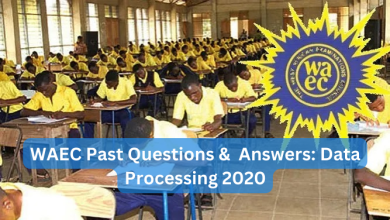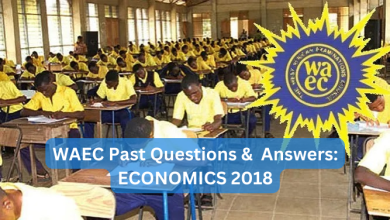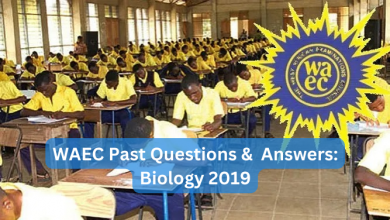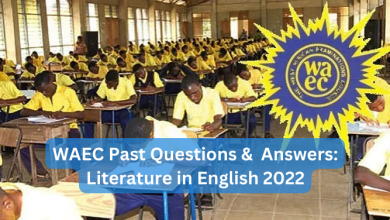EducationWAEC Past Questions and Answers
WAEC Past Questions & Answers: CHEMISTRY 2001

Welcome to our WAEC past question and answer series. In this post, we will be sharing Chemistry 2001 past questions and answers. Stay tuned enjoy while learning.
1. Elements which belong to the same group in the Periodic Table are characterized by
A, difference of +1 in the oxidation numbers of successive members
B presence of the same number of outermost electrons in the respective atoms
C difference of 14 atomic mass units between successive members
D presence of the same number of electron shells in the respective atoms
Ans: B
2. The atom of an element X combines with aluminium (13AI)?
A AIX 2
B AI 2X
C AI2X 2
D AI 2X 3
Ans: D
3. The presence of unpaired electrons in an atom of a transition metal gives rise to
A paramagnetism
B nalleability
C ductility
D shiny appearance
Ans: A
4. What is responsible for metallic bonding?
ASharing of electrons between the metal atoms
BAttraction between the atomic unclei and cloud of electrons
C transfer of electrons from one atom to another
D Attraction between positive and negative ions
Ans: B
5. Which of the following compounds is covalent?
ACaCI2
B MgO
CNaN
DCH4
Ans: D
6. A sheet of paper is placed in the path of a beam from a radioactive source. The emissions that pass through the paper consist of
Aalpha particles and gamma rays
B alpha and beta particles
Cbeta particles and gamma rays
D alpha particles only
Ans: C
7. Which of the following features of a human skeleton can be determined by carbon-dating?
AHeight
BMass
C Age
D Race
Ans: C
8. Which of the following statements about ideal gases is/are correct? 1. The cohesive forces between their particles are negligible ll. The have no definite volume but occupy the volume of their containers III. They are not compressible IV. Their particles collide with loss of energy
Al only
B l and ll only
C l, ll and lll only
D l, ll, lll, and IV
Ans: B
9. P Total = F1 + P2 + P 3 + ………Pn’ where P Total is the pressure of a mixture of gasses. The equation above is an expression of
AGraham’s law
B Gay-Lussac’s Law
CBoyle’s law
D Dalton’s law
Ans: D
10. Which of the following pairs of reagents react to produce hydrogen?
A Zinc and concentrated trioxonitrate (V) acid
B Water and calcium dicarbide
C Copper and dilute hydrochloric acid
D Magnesium and dilute tetraoxosulphate (VI) acid
Ans: D
11. A mixture of calcium chloride and calcium trioxocarbonate (IV) in water can be separated by
Aevaporation
B sublimation
C distillation
D filtration
Ans: D
12. Which of the following would dissolve in warm dilute H2SO4 without effervescence, to give a blue solution?
A Copper turnings
BCopper (ll) trioxocarbonate (IV)
C Copper (ll) oxide
D Copper alloy
Ans: D
13. In which of the reactions represented by the following equations is HNO3 behaving as a typical acid?
A CaO + 2HNO3 → Ca(NO3) 2 + H 2O
B Cu + 4HNO3 → Cu(NO 3)2 + 2H2O + 2NO2
C S + 6HNO3 → H2SO 4 + 6NO2 + 2H2O
D P + 5HNO3 → H 3PO 4 + 5NO2 + H2O
Ans: A
14. A gas was evolved when a sample of gastric juice reacted with sodium trioxocarbonate (IV) . The gas evolved was
ANH3
B SO2
CHCI
DCO2
Ans: D
15. It can be concluded that gastric juice
A contains enzymes
B is acidic
Cis a mixture
D has pH value of 7
Ans: B
16. What does ∆H represent in the following equation ? Cl(g) + e- → CI- (g); ∆H = – 363 kJ mol-1
Alonization energy
BElectron affinity
C Dissociation energy
D Heat of atomization
Ans: B
17. Consider the following equation: Ag+ (aq) + CI-(aq) → Ag+CI- (s) ; ∆H = _65.7 kJmol-1. From the equation, it can be deduced that
Adirect combination is involved and the reaction is endothermic
B a solid is formed and heat is evolved
C activation energy is high and a catalyst is required
D the reaction is endothermic and occurs at high temperature
Ans: B
18. A reaction is represented by the equation below. A2(g) + B2(g) 2AB(g); ∆H = +X kJmol-1 Which of the following statements about the system is correct?
A The reaction goes to completion at equilibrium
B The forward reaction is exthermic
CAt equilibrium increase in temperature favours the reverse reaction
D Pressure has no effect on the equilibrium mixture
Ans: D
19. What is the oxidation number of nitrogen in AI(NO3)3?
A+ 1
B + 3
C+ 5
D+ 6
Ans: C
20. What is oxidized in the reaction represented by the following equation? 3CU + 8HNO3 → 3Cu(NO3)2 + 2NO + 4H2O
A Oxygen
BHydrogen
C Nitrogen
D Copper
Ans: D
21. Which of the following substances decomposes when an electric current is passed through it?
A Glucose solution
B Zinc rod
CHydrochloric acid
D Tetrachlormethane
Ans:
22. A concentrated solution containing H+, Cu2+,OH– and CI– was electrolysed using platiunm electrodes which of the ions will be discharged at the cathods?
A H+
B Cu2+
C OH–
D CI–
Ans:
23. Given that the order of reactivity of four metals is P>Q>R>S, which of the following reactions is feasible?
A S + P+ → P + S +
B Q + S+ → S + Q+
C R + P+ → P + R+
D S + Q+ → Q + S+
Ans:





